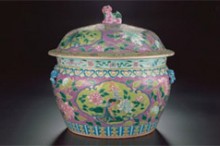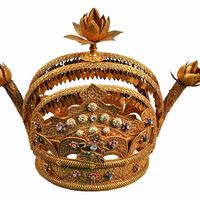Exhibition: "The Peranakan World" | India

 Between 10 February and 25 March 2015, the National Museum of India, in New Delhi, an ASEMUS member, presents an exhibition entitled "The Peranakan World: Cross Cultural Art of Singapore and the Straits of Malakka".
A slice of the spectacular cross-cultural traditions of the Peranakan Chinese in Singapore and the surrounding region is on display in this special exhibition. Peranakan comes from the malay word anak, which means "child" and implies a person born of mixed heritage. The Peranakan Chinese are descendants of southern Chinese traders who settled in Southeast Asia and married local women. Their culture is rooted in Chinese traditions, but with strong influences from Southeast Asia and Europe. Peranakan art in this exhibition reflects these diverse influences. Chinese, Malay, Indian, and European cultures were fused into a distinctive style. The Peranakan phenomenon of blending different cultures and adapting to local situations retains its resonance today.
The exhibition showcases an assortment of art objects including gold and diamond jewellery; belt buckles; porcelain; furniture; batik work; altar cloths; and beadwork.
The Peranakans commissioned their jewellery from Malay, Chinese, Indian, and European jewellers, which led to diverse techniques and designs. Chinese and Malay decorative motifs were frequently combined. The kerosang - a heart-shaped brooch - perhaps the most iconic of Peranakan jewellery - is derived from a Portuguese form.
Jewellery for celebratory occasions such as weddings was primarily made of gold and diamonds, or occasionally semi-precious stones. During mourning periods, silver and pearls were used; pearls were thought to represent tears.
This is the first time that an exhibition of the Peranakan Chinese culture is being held in India. The objects at the exhibition, most of them dating from the late 19th and early 20th centuries, have been lent by the Asian Civilisations Museum and the Peranakan Museum in Singapore, both of which are also ASEMUS members.
For additional information, visit http://www.nationalmuseumindia.gov.in/exhibitions-the-peranakan-world.asp?lk=ex1
Pictures: Large pink kamcheng China, Guangxu period (1875–1908) Porcelain gift of Professor Cheah Jin Seng 2012-00831; and Kerosang Straits Settlements, late 19th or early 20th century gold, diamonds gift of Mr Edmond Chin 2002-00508.1-3
Between 10 February and 25 March 2015, the National Museum of India, in New Delhi, an ASEMUS member, presents an exhibition entitled "The Peranakan World: Cross Cultural Art of Singapore and the Straits of Malakka".
A slice of the spectacular cross-cultural traditions of the Peranakan Chinese in Singapore and the surrounding region is on display in this special exhibition. Peranakan comes from the malay word anak, which means "child" and implies a person born of mixed heritage. The Peranakan Chinese are descendants of southern Chinese traders who settled in Southeast Asia and married local women. Their culture is rooted in Chinese traditions, but with strong influences from Southeast Asia and Europe. Peranakan art in this exhibition reflects these diverse influences. Chinese, Malay, Indian, and European cultures were fused into a distinctive style. The Peranakan phenomenon of blending different cultures and adapting to local situations retains its resonance today.
The exhibition showcases an assortment of art objects including gold and diamond jewellery; belt buckles; porcelain; furniture; batik work; altar cloths; and beadwork.
The Peranakans commissioned their jewellery from Malay, Chinese, Indian, and European jewellers, which led to diverse techniques and designs. Chinese and Malay decorative motifs were frequently combined. The kerosang - a heart-shaped brooch - perhaps the most iconic of Peranakan jewellery - is derived from a Portuguese form.
Jewellery for celebratory occasions such as weddings was primarily made of gold and diamonds, or occasionally semi-precious stones. During mourning periods, silver and pearls were used; pearls were thought to represent tears.
This is the first time that an exhibition of the Peranakan Chinese culture is being held in India. The objects at the exhibition, most of them dating from the late 19th and early 20th centuries, have been lent by the Asian Civilisations Museum and the Peranakan Museum in Singapore, both of which are also ASEMUS members.
For additional information, visit http://www.nationalmuseumindia.gov.in/exhibitions-the-peranakan-world.asp?lk=ex1
Pictures: Large pink kamcheng China, Guangxu period (1875–1908) Porcelain gift of Professor Cheah Jin Seng 2012-00831; and Kerosang Straits Settlements, late 19th or early 20th century gold, diamonds gift of Mr Edmond Chin 2002-00508.1-3Similar content
23 May 2015 - 03 Apr 2016
from - to
19 Mar 2013 - 19 May 2013
24 Jun 2016 - 26 Mar 2017
31 Oct 2015
06 Sep 2018 - 04 May 2019

